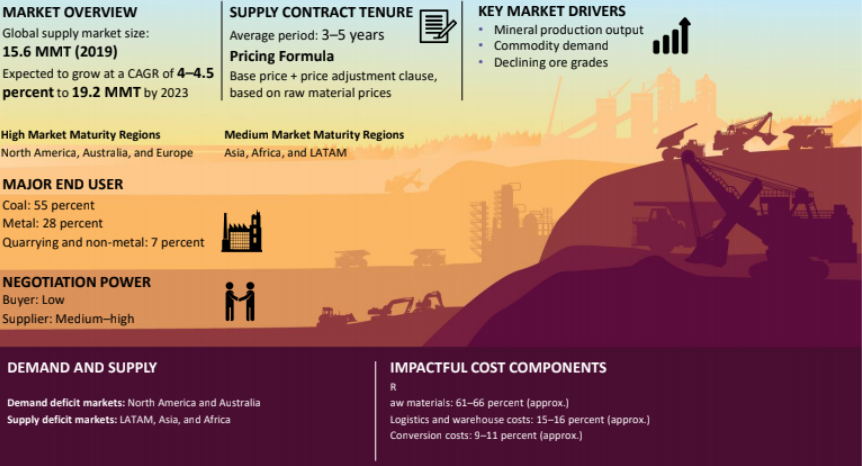CATEGORY
Explosives
Explosives are used in mining site to break through rock formation for excavation.
Beroe LiVE.Ai™
AI-powered self-service platform for all your sourcing decision needs across 1,200+ categories like Explosives.
Market Data, Sourcing & Supplier Intelligence, and Price & Cost Benchmarking.
Schedule a DemoCategory Alerts
Omnia secures JV with Indonesian mining explosives business
March 31, 2023Orica introduces 4D? bulk explosives system for underground operations
March 31, 2023Digital Terrain completes acquisition of explosives magazine management software specialist Magman
March 31, 2023Become a Beroe LiVE.Ai™ Subscriber to receive proactive alerts on Explosives
Schedule a DemoExplosives Market Monitoring Dashboard
Understand the correlation between costs, margins, and prices impacting your category on a real time basis on Beroe LiVE.Ai™
Schedule a DemoExplosives Industry Benchmarks
Savings Achieved
(in %)
The average annual savings achieved in Explosives category is 5.30%
Payment Terms
(in days)
The industry average payment terms in Explosives category for the current quarter is 56.3 days
Compare your category performance against peers and industry benchmarks across 20+ parameters on Beroe LiVE.Ai™
Category Strategy and Flexibility
Engagement Model
Supply Assurance
Sourcing Process
Supplier Type
Pricing Model
Contract Length
SLAs/KPIs
Lead Time
Supplier Diversity
Targeted Savings
Risk Mitigation
Financial Risk
Sanctions
AMEs
Geopolitical Risk
Cost Optimization
Price per Unit Competitiveness
Specification Leanness
Minimum Order Quality
Payment Terms
Inventory Control
The World’s first Digital Market Analyst
Abi, the AI-powered digital assistant brings together data, insights, and intelligence for faster answers to sourcing questions
Abi is now supercharged with GPT4 AI engine. Enjoy the ease of ChatGPT, now on Abi

Use the Explosives market, supplier and price information for category strategy creation and Quaterly Business Reviews (QRBs)
Schedule a DemoExplosives market report transcript
Global Market Outlook on Explosives
MARKET OVERVIEW
Global Supply: 14.65 MMT (2022E)
Global Demand: 13.59 MMT (2022E)
Global Demand CAGR: Approx. 3.5–4 percent (2021–2024)
-
The demand for explosives is driven by rising commodity consumption levels from China, India, and other Asian countries. This scenario is expected to continue in 2022 with higher demand from countries, like India and China
-
A constant rise in commodity demand, coupled with increasing mineral output, and declining ore heads are the key drivers for explosives

Global Explosives - Drivers and Constraints
Drivers
Increase in Commodity Demand
-
The mining industry is expected to witness a 22 percent increase in capital expenditure in 2022, as overall prices and demand for metals and minerals are expected to improve in 2022
-
Commodities, such as copper, gold, iron ore, etc., have a positive impact on demand for explosives, due to the expansion of mining activity
Rise in Commodity Prices
-
It results in high-profit margins for mining companies, which triggers Greenfield and Brownfield mine project expansion
Technology Changes
-
Major explosive manufacturers invest significantly in R&D in order to develop innovative products, which improves the efficiency of blasting as well as result in lower GHG emissions. This helps the mining industry meet the emission targets
Constraints
Decrease in Mineral Output Growth Rate
-
It will result in a reduction in mineral output from mines, adversely impacting explosives demand
Regulations and Complexity in Transportation and Logistics
-
Increasing security and safety regulations have had a negative impact on the sales and supply of explosive products, especially in mining destinations, such as Africa, LATAM, etc.
-
Such stringent regulations affect the supply security and have impacted blasting services cost significantly
Decarbonizing
-
The global shift toward phasing out the use of coal for energy needs would significantly impact the demand for explosives, as coal mining industry is the largest end-user of explosives at present
Market Driver - Commodity Price
-
Prices of key commodities are the best indicators of mining activities, which, in turn, evinces the demand for explosives
-
Iron ore prices have increased by 19.5 percent and averaged at $111/MT, due to improved demand from the end users
-
LME Nickel prices averaged at $13.17/lb. in December 2022, a monthly rise of around 12.2 percent compared to $11.56/lb. in Nov 2022
Cost Structure Analysis : Explosives
-
Feedstock raw materials are the key cost drivers for explosives, as they constitute to ~60–70 percent of the total production cost across all regions.
-
The profit margin for explosives in a particular region is set up by the supplier, based on demand from the customers in that region and competition among the suppliers
-
Other costs are inclusive of logistics, warehouse cost, and other direct and indirect expenses
-
Utilities mainly include storing of AN prill at the appropriate temperature, as it should not be subjected to extreme external conditions of rain, high humidity, etc.
Interesting Reads:
Discover the world of market intelligence and how it can elevate your business strategies.
Learn more about how market intelligence can enable informed decision-making, help identify growth opportunities, manage risks, and shape your business's strategic direction.